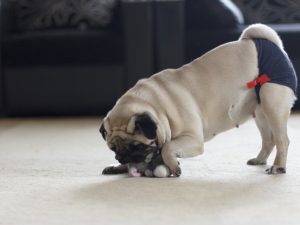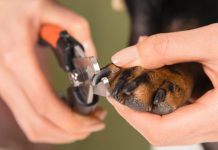 We all know that animals rely on their instincts for breeding. However, as in humans, it is not always a straightforward process. In specific cases, an animal may require human intervention when some challenges arise. For instance, a female canine could be experiencing problems with expectancy or difficulties in giving birth.
We all know that animals rely on their instincts for breeding. However, as in humans, it is not always a straightforward process. In specific cases, an animal may require human intervention when some challenges arise. For instance, a female canine could be experiencing problems with expectancy or difficulties in giving birth.
Moreover, when she experiences the first heat step, you must be aware of how to behave regarding this condition. Acquiring knowledge on how long does a dog stay in heat provides a possibility for adequate preparation.
This article offers an in-depth breakdown of the heat cycles of a dog. It seeks to address the relevant common questions about this subject at hand. In understanding how long does a dog stay in heat, and how a pet owner can deal with this condition, you edge closer to a more responsible pet owner.
Understanding the Four Heat Phases
Heat is also known as the canine estrus cycle. Dogs typically experience this cycle either biannually or annually. A complete cycle generally happens in four phases lasting between fourteen to twenty-one days.
By knowing about each of these stages, you can acquire a clearer idea of what to expect during your pet’s cycle. Moreover, you will be able to prepare for this period adequately, as well as notice any abnormal behaviors or difficulties of your canine in case they arise. Let’s examine the heat cycle phases in detail.
Proestrus
In this initial time, the organism of the canine is prepping for mating. Hence, the genitals enlarge. One might notice some discharge from the vagina that contains traces of blood. Nonetheless, canines can be meticulous about messes. More often than not, your dog will normally clean themselves up before it catches your eye.
This discharge is biologically aimed to attract male dogs within this time. However, it is too early to conceive. Thus, an animal tends to be unreceptive to all other companions. At times, a female canine can even be hostile to the other canines.
Estrus
During this period, the canine becomes ready to engage the advances. Typically, her window for breeding is incredibly brief, sometimes lasting only three days. The discharge of blood decreases until there is no more red substance. However, some discharge may still be noticeable, albeit with a pale-yellow mess.
 At this point, female dogs still attract males. At this time, however, females are responsive and accepting some of the advances. It happens in preparation for ovulation, which occurs within twenty-four to thirty-six hours after the mating process.
At this point, female dogs still attract males. At this time, however, females are responsive and accepting some of the advances. It happens in preparation for ovulation, which occurs within twenty-four to thirty-six hours after the mating process.
During this phase, dogs tend to urinate more frequently, usually marking spots around their residence. Such behaviors intend to deliver a pheromone message that conveys readiness for copulation. Once a “suitable” male appears, the female dog will likely pursue him, prepared for the mating process ahead.
Diestrus
This period happens immediately after your pet is out of heat. She will be immensely unreceptive to mating advances during this phase. It takes approximately eight weeks.
Depending on the mating outcome, it may go two ways:
- If conception took place, the fetuses have started forming in the canine. When carried to term, diestrus lasts the entirety of her gestation.
- If not, she starts the rest phase where her body returns to normal physiological processes. In this period, the vulva reduces back to its usual size. Furthermore, the discharge ceases completely disappear.
Anestrus
The body is repairing the uterus, as the reproductive channel rests. The female canine is unlikely to show any sexual behaviors during the entirety of this phase, and there are no abnormal hormonal tendencies. Usually, this stage remains until the next time the heat cycle occurs.
Understanding What Is Estrus
It is essential to understand what estrus is before moving forward to behavior recommendations. In the history of man domesticating dogs, we had a special focus put on their breeding. You may be wondering if other animals experience their heat cycles in a relatively similar fashion to dogs. However, it undoubtedly varies significantly from the menstrual process in humans.
Naturally, all animals that reproduce sexually know when it is right to do so. You will also notice it in your pet. Usually, a dog in its cycle will be somewhat grumpy during the first stages. Whenever another dog attempts to mount on them, they will generally ward them off.
However, as the cycle progresses, you will notice that the female pet becomes a bit more flirtatious as if she is implying being fertile and eager to reproduce. Playing a significant part when your pet is in heat is not only an extension of care but also an opportunity for you to learn more about your dog.
 So, estrus is a point in the procreative course of an animal in which they are prepared and able to mate. To put it concisely, this is the duration when your pet is physiologically in a position to breed with other males. Estrus begins with a surge in the amount of estrogen in the body. It, typically, precedes a sharp decline in the levels. Mature eggs, with the potential of either fertilization or withdrawal from the body, are released from the ovaries.
So, estrus is a point in the procreative course of an animal in which they are prepared and able to mate. To put it concisely, this is the duration when your pet is physiologically in a position to breed with other males. Estrus begins with a surge in the amount of estrogen in the body. It, typically, precedes a sharp decline in the levels. Mature eggs, with the potential of either fertilization or withdrawal from the body, are released from the ovaries.
Some dog owners prefer to have their pets spayed, and we will take about it below. In short, you can carry out this before the pet enters her first estrus cycle. It ensures that the probability of your dog producing mature eggs reduces close to nil.
How Prolonged Will It Be?
How long does a dog stay in heat for is quite a sensitive matter for any concerned owner. Your pet will normally remain in heat for a short duration, which arguably varies with different breeds. Most of them, nevertheless, stay in that state for approximately a week. Out of these seven or so days, females will only yield for a considerable fraction. It is unlikely to exceed three days.
Nevertheless, this particular behavior tends to last longer for males. Such a thing also happens to be the statement with all species that reproduce sexually so that males get attracted to females for about two more weeks. Nonetheless, it relies on the type of dog you own.
What Signs Do You Need to Look Out For?
Knowing and understanding this condition is paying attention to several factors. For first-time dog owners, it hinges on observation significantly. As a responsible pet owner, you certainly need to be fully accountable for your pet. Thus, you have to spend enough time with your dog to distinguish between normal and peculiar behaviors.
Second, you should have a clear idea of what characteristics you are looking for, meaning you can’t spot the condition that you are not aware of. You would have to research the particular peculiarities that stand out during this process. It will help a lot if you talk to seasoned dog owners, who might know much about this condition in dogs. This conversation should, preferably, augment whatever findings your research has yielded.
More so, it would be just as advisable to consult animal specialists. During one of the routine checks at a vet clinic, why not gain some information on the worrying topic? Ask the vet all queries you have, including how long does a dog stay in heat. By combining all relevant information received, you can put yourself in an undoubtedly strong position of knowing when the canine experiences the first step.
What to Do When It Happens?
The query, how long does a female dog stay in heat for, usually has several follow-up concerns. In any case, your pet requires utmost care, and especially within this time, you need to stay attentive to your dog. Most important, a female canine should never be unaccompanied outdoors and walked off the leash. Instincts compel her to be aggressive towards other female dogs in the cycle. Not only will it protect your pet from possible physical harm but also reduce the chances of getting accidental puppies.
 Note that the discharge released during the heat period can be quite unsettling and uncomfortable to the eye and nose. It would, therefore, be best if your pet gets confined to a space that does not require a lot of effort to clean up. To avoid messes altogether, you can always buy dog panties.
Note that the discharge released during the heat period can be quite unsettling and uncomfortable to the eye and nose. It would, therefore, be best if your pet gets confined to a space that does not require a lot of effort to clean up. To avoid messes altogether, you can always buy dog panties.
A female dog is also likely to be hostile with other animals around her. In this case, it would be advisable to separate her from other pets in your house since it is only a temporary problem.
When Will the Dog Experience the First Cycle?
In most cases, it will occur before your dog turns two. But also, remember that it varies with the breed. As such, the first heat cycle occurs sooner in smaller breeds and considerably later in the large ones.
It might be your first experience, and you think that it is worth considering that the situation may not be as immense as it may sound or seem. Granted, the case that the change in your dog’s behavior may be unprecedented, you are unlikely to be overwhelmed by the experience. It may turn out to be quite gratifying, for instance, when the dog gets increasingly clingy to you.
How Regularly Will My Dog Go into Heat?
To understand all that, you should take into account the breed of your dog. The reason here is that the frequency of occurrences varies with the type of canine. On the other hand, the physiology of an individual animal will also matter. In general, it will occur either bi-annually or yearly. With this info, you should now be confident that you have standing answers to the recurrent puzzle, how long does a female dog stay in heat and how often she experiences it.
How Can I Tell That It Happens?
Many people who own dogs don’t recognize the first signs during such times. Remember, knowing that your pet is in the respective condition is incredibly important. She will possibly exhibit strange behaviors and be edgier and erratic than what you would consider her usual response. You may also notice evident changes in her concentration spans. During the cycle, a female canine gets distracted quite quickly, a bit more than usual.
A dog might even urinate around different spots in your home. At this moment, she will be sending a message to her potential mates that she is ready to reproduce. Even her demeanor towards the mating advances changes. The ups and downs in her hormonal levels will subsequently lead to noticeable changes in behaving. For instance, a canine might become clingier than how she usually is.
Furthermore, the physiological differencies will be clear signs. You will likely spot discharge, which may contain traces of blood. Nevertheless, the color will change later during the next stage.
Can I Protect My Dog from Experiencing Heat?
 After considering, how long does a female dog stay in heat, you are possibly in search of a permanent action to this struggle. Several ways can come in handy to halt this process. However, just one stands in the prevention of your dog from going through this biological process. It is highly advisable always to seek professional guidance. A qualified vet is the only authority who should take care of this predicament.
After considering, how long does a female dog stay in heat, you are possibly in search of a permanent action to this struggle. Several ways can come in handy to halt this process. However, just one stands in the prevention of your dog from going through this biological process. It is highly advisable always to seek professional guidance. A qualified vet is the only authority who should take care of this predicament.
Usually, spaying is the most effective procedure to stop the onset of the period in your dog. This treatment process not only ensures that your pet does not go through an estrus or unplanned pregnancy but also reduces the chances of succumbing to diseases related to reproduction.
The Perfect Timing for Canine Spraying
The exact age to sterilize your pet varies. Typically, a dog can undergo this procedure even as young as eight weeks old. After all, this is what happens in most pet shelters.
Nevertheless, it is smart to reach this decision with your vet’s insight. There might be unforeseen factors that may require professional guidance to address. In any case, you will be confident that the specialist will make the most reliable recommendation when it comes to the ideal time for spraying the dog.
Final Thoughts
Many dog owners get confused and curious about the occurrence of the situation when their dog experiences a heat process. By reading this article, you are aware of how long does a dog stay in heat the first time, as well as how one can help their canine during this stage.
I hope that this article was not only informative but also helpful as you look after your dog. You are as lucky to have a dog as the dog feels fortunate to have you. Here’s why you need to provide the utmost care while the dog is in heat and think about preventive spraying approaches to help your pet.










